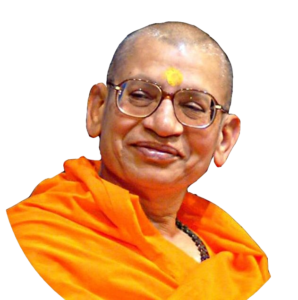
By Swami Viditatmananda Saraswati*
Na Me Bhaktaḥ Praṇaśyati – 08
Upāsanā is meditation on saguṇa-brahma. Meditating is defined as maintaining a flow of thoughts of which the subject is īśvara. Mentally dwelling upon īśvara in this way is called upāsanā. In contrast to pūjā, worship that engages the body, speech and mind, or kīrtanam, worship that engages the speech and mind, upasanā is worship that engages the mind only. It is mental worship in which the focus of the mind is extremely restricted, deep, and centred. The goal of upāsanā is to improve the ability of the mind to concentrate on īśvara as the chosen subject and to cultivate the attitude of reverence and devotion for īśvara.
Upāsanā can take the form of mental kīrtanam. For example, the meditator might dwell on the form and characteristics of an iṣṭa-devatā, a chosen deity, such as Lord Krishna or Lord Śiva. Having already cultivated devotion and concentration of mind through śravaṇam and oral kīrtanam, listening to and singing the glories of the chosen form, the devotee now performs mental kīrtanam. In mental kīrtanam, the meditator maintains a steady flow of thoughts of īśvara by mentally chanting his names and attributes.
Upāsanā can also take the form of mānasa-pūjā, mentally performing pūjā, ritual worship, to the chosen deity. Without external form and materials of worship, the devotee worships īśvara in the mind, performing the same steps of the ritual and chanting the same hymns or mantras, but doing it all mentally only. Mānasa-pūjā requires and cultivates much more concentration of mind than the same pūjā performed physically.
Also read: Spirituality: Make īśvara the only agenda in your life
Mental japa of a mantra or a name of the Lord is another excellent way to cultivate concentration of mind and maintain a consistent flow of thoughts having īśvara as the subject. Performing mental japa with devotion is critical, so the chosen mantra or name should be one that invokes devotion and love in the heart of the meditator. The emotion of love and devotion plays a pivotal role in the purification of the heart by which one neutralizes rāga and dveṣa, thereby ultimately overcoming the false notion of separation and becoming absorbed in the oneness that is īśvara, brahman.
Both the Yoga Sūtra and the Bhagavad Gita recommend the practice of abhyāsa, repetition, and vairāgya, dispassion, to overcome the distraction of rāga and dveṣa, attachment and aversion, during meditation. When the mind is distracted from the appointed object of meditation due to attraction or aversion to an outside object, disengage the mind from that distraction by recognizing that attraction or aversion arises only from the projection of the mind; the object is neither a source of pleasure nor pain. That is the vairāgya, dispassion. Disengaging the mind from the objects of the world and bringing it back to the appointed object of meditation again and again is abhyāsa, repetition.
By upāsanā, maintaining the flow of thoughts having īśvara as the object of thought, the mind gradually takes the form of the Lord. Gradually the qualities of the Lord begin to manifest in the devotee’s personality. The mind becomes less attached to the distractions of the world and more available for jñānayoga, the second stage of devotion, in which meditation is upon nirguṇa-brahma. Contemplation on nirguṇa-brahma, the one self of the jīva and īśvara, culminates in knowledge of the identity between jīva and īśvara.
Karma-yoga is offering actions with devotion
Pūjā, śravaṇam, kīrtanam, and upāsanā on saguṇa-brahma are forms of worship that are the means for expressing and for discovering bhakti, the spirit of devotion. They are all forms of karma-yoga, the first stage of devotion. Now you might object that you don’t have the time or materials to do pūjā, kīrtanam, or meditation. Lord Krishna says not to worry about that. His simple instruction is, “yat karoṣi, whatever you do, tat kuruṣva madarpaṇam, do it as an offering to me.” Offer your karma, actions, to the Lord. Call it karma-yoga. Karma-yoga is performing duty in the spirit of offering.
You might wonder, “What do I have to offer?” What you offer to the Lord is not important. A leaf is a thing without any value. What makes it valuable is the bhakti. Yo me bhaktyā prayacchati, the love with which the devotee offers it makes it valuable. Similarly, karma, an action, may not be valuable by itself; yet Lord Krishna says whatever karma you perform, offer it to me. We need an offering, an expression, a form, something for physicalizing the attitude or spirit that we have. In this way, any karma, any action that we perform, becomes a means for expressing our feelings for the Lord. Bhakti begins with conviction and then creates a devotee in me. Devotion is in the heart, but it is given expression in the form of offering to the Lord. What I have to offer is my karma, my actions.
Lord Krishna says na me bhaktaḥ praṇaśyati, my devotee never suffers a distraction, never suffers a decline, never deviates from his path. My bhakta always continues to grow in this path of devotion, a path of self-growth, a path of progressively reducing the distance between the devotee and the Lord.
The ultimate goal is that what appears as two becomes one. That is jñāna-yoga. Right now, I look upon myself as an individual, separate from īśvara. Even though I know that in the ultimate reality, īśvara is myself, right now that is not a reality for me. Therefore, we begin from where we are. Right now we are at a point where we feel a difference from īśvara. Begin from there. Bhakti in the form of karma-yoga is properly conducting ourselves in the realm of duality so as to overcome the duality.
Within the duality, we can either function in such a manner that our separation from īśvara keeps on growing, or we can function in a manner that reduces the separation. Overcome the duality with duality. Worshipping īśvara with the attitude of duality is a temporary tool that enables us to rise in purity and reduce the separation until the duality is dropped and we discover the nonduality. Just as the pole vaulter drops the pole upon reaching the height, we drop duality when we discover nonduality as ourselves.
…to continue
*Swami Viditatmananda Saraswati has been teaching Vedānta Prasthānatrayī and Prakaraṇagranthas for the last 40 years in Ahmedabad, Gujarat. Throughout the year, he conducts daily Vedānta discourses, accompanied by retreats, and Jñāna Yajñas on Vedānta in different cities in India and foreign countries.






